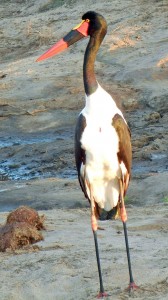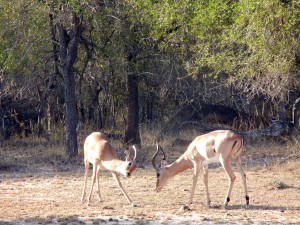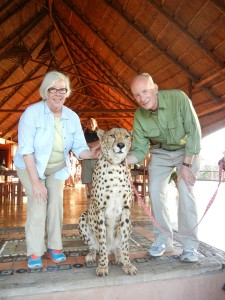by Sedgwick Clark
I’ve been promising to run photos from our African vacation in this space almost since we returned two months ago. The lone dissenter (“You’re not really going to post photos from your Safari on Musical America.com!! Oy.”) was far outvoted. Only yesterday I ran into a friend who had seen photos posted in a decidedly more timely fashion on our fellow traveler Peter Clark’s Facebook page, and she expressed interest in seeing more. It was difficult to choose from all we took, and I may even have more next week.
The trip was planned by ROAR AFRICA, which we all agreed thoroughly lived up to advance praise. We flew to Johannesburg but after a four-hour layover continued to Cape Town rather than face the former’s notorious crime level. Both of the cities’ airports were strikingly up-to-date and clean, however. Once in Cape Town, we were met by ROAR AFRICA guide Andy Ward, a retired geography teacher, who had the answers for all of our questions and made us feel completely safe and at ease.
Exploring the wine lands and partaking in wine, goat cheese, and chocolate (!) tastings was a relaxed way to overcome 20-some hours of travel. We also visited the Spier Wine Estate, which houses a bird sanctuary and a Cheetah Outreach Program where over 20 of these beautiful, endangered cats live.
We also visited the Hout Bay Music Project, which I wrote about on May 24, while still in Africa. We took so many photos that I’ll put a few of them together in a future week of their own.
The first three photos cover our time in Cape Town before flying east to Kruger National Park, where more colorful beasts roam. All photos were taken by yours truly or Peggy Kane unless otherwise noted.
Many thanks to Stephanie Challener for her assistance in posting these photos.
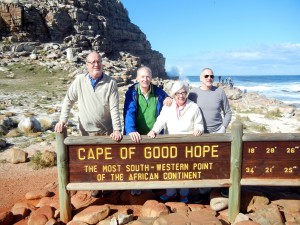
(left to right) The intrepid travelers: Peter Clark, Sedge, Peggy Kane, and Jonathan Rosenbloom at the Cape of Good Hope.
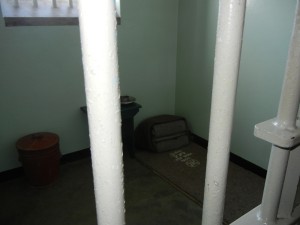
Nelson Mandela’s prison cell for 18 years on Robben Island. The Dutch settled the Cape in the mid-1600s and established the island primarily as a prison. Since 1997 it has been a living museum and a focal point of South African heritage, with tours given by former prison inmates.
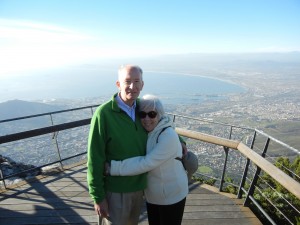
Sedge and Peggy on 3,000-foot Table Mountain with Cape Town in background to the west. Possessed of an unfortunate urge to jump from such heights, I dared venture no further out onto this overlook’s precipice, to Peggy’s amusement. Many young visitors would lean over the railing, presumably to enjoy the precipitous drop, but compelling me to head for center ground. On our 3,500-foot descent in the cable car, to avoid the 360-degree views afforded by the car’s revolving floor, I kept my cookies down by engaging our guide Andy in an eyes’-locked discussion about the upcoming American presidential election.
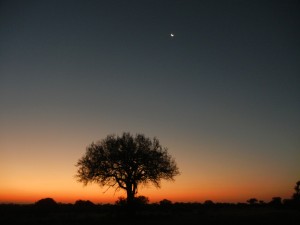
Safari at dawn with tree and crescent moon. Bush safaris in the Tinga and Lion Sands Game Preserves were from 6-9:00 a.m. and 4-7:00 p.m., returning to camp for breakfast and for dinner, respectively. In between, we could watch the elephants cavort in the Sabie River or take a nap.
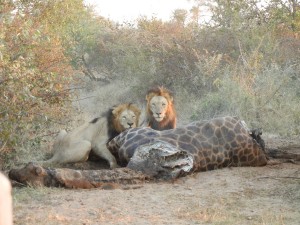
It’s a matter of pride for the safari rangers and trackers to find the Big 5 (lion, leopard, elephant, rhino, and buffalo), as well as hippo and giraffe. A tip from a fellow ranger led us to this scene. The giraffe had been killed by different lions three days before, and these lions (pictured) had ventured out of their own territory from a neighboring park across the Sabie. Before we approached the kill, our ranger stopped the Land Rover and plucked fever bush leaves for each of us to smell. We were very grateful.
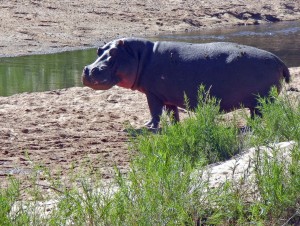
A hippo close-up on a walking tour. Unlike when we were safely seated in the Land Rover, our ranger and tracker each carried a rifle. We were warned that if he should turn on us and charge, the worst thing we could do would be to run! Fortunately he lumbered off into the river.
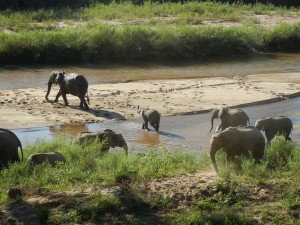
Of the Big 5, elephants are the most prolific. We have photos of them everywhere, crossing highways, jamming traffic as they lumber down dirt safari roads, knocking down trees to eat their roots, crossing the Sabie River.
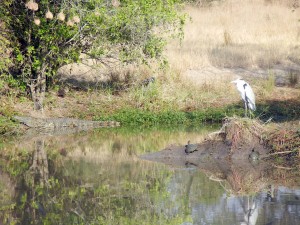
A crocodile lies in wait beneath weaver bird nests, while two terrapins clamber out of the water and a white heron keeps watch.
Despite reassurance that this family of grazing rhinos was allowing us into its territory, being just 20 feet from this most prehistoric-looking of living animals generated a palpable sense of awe and danger.
